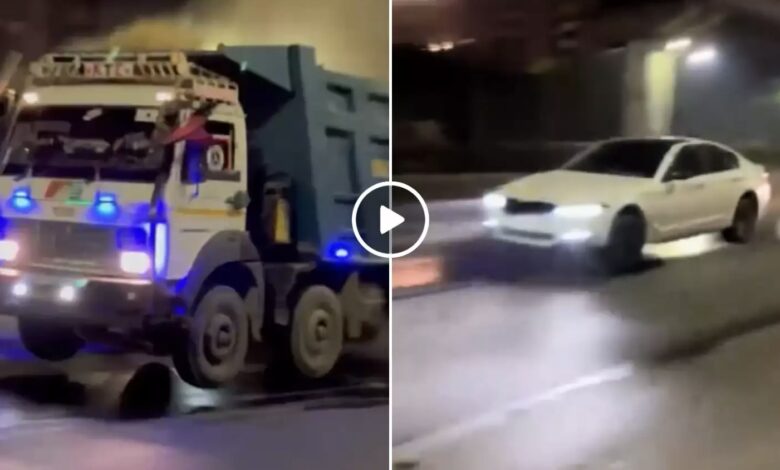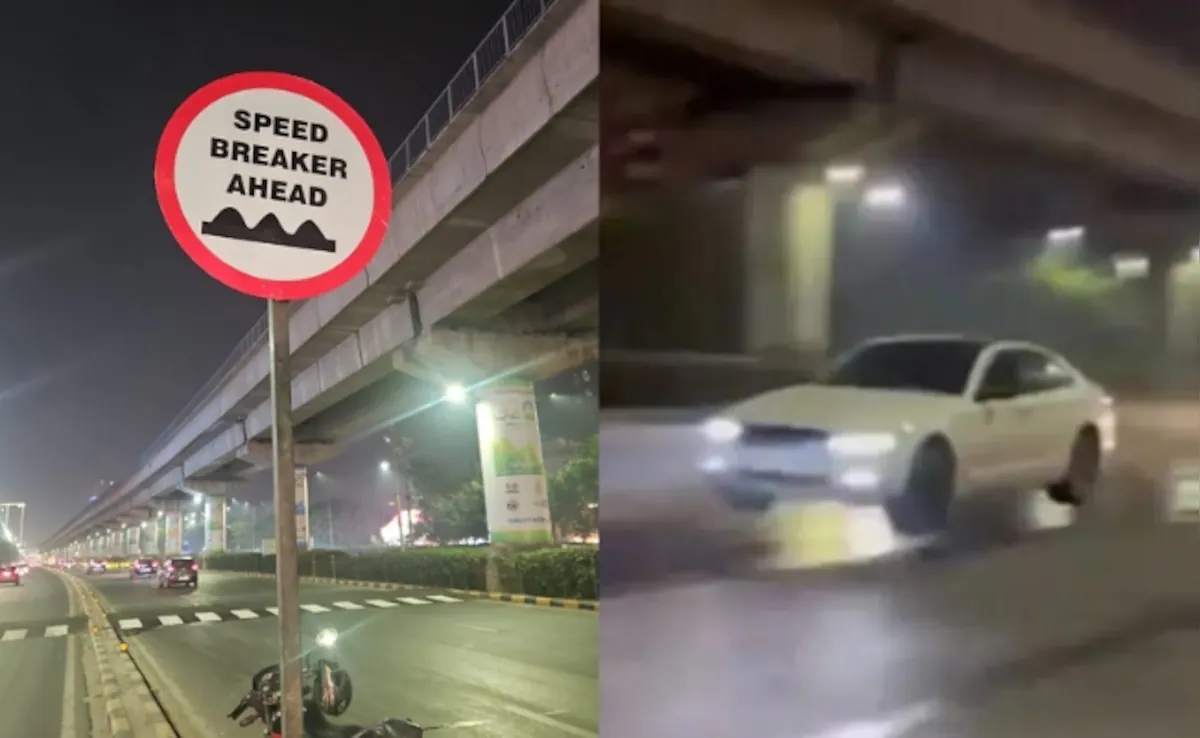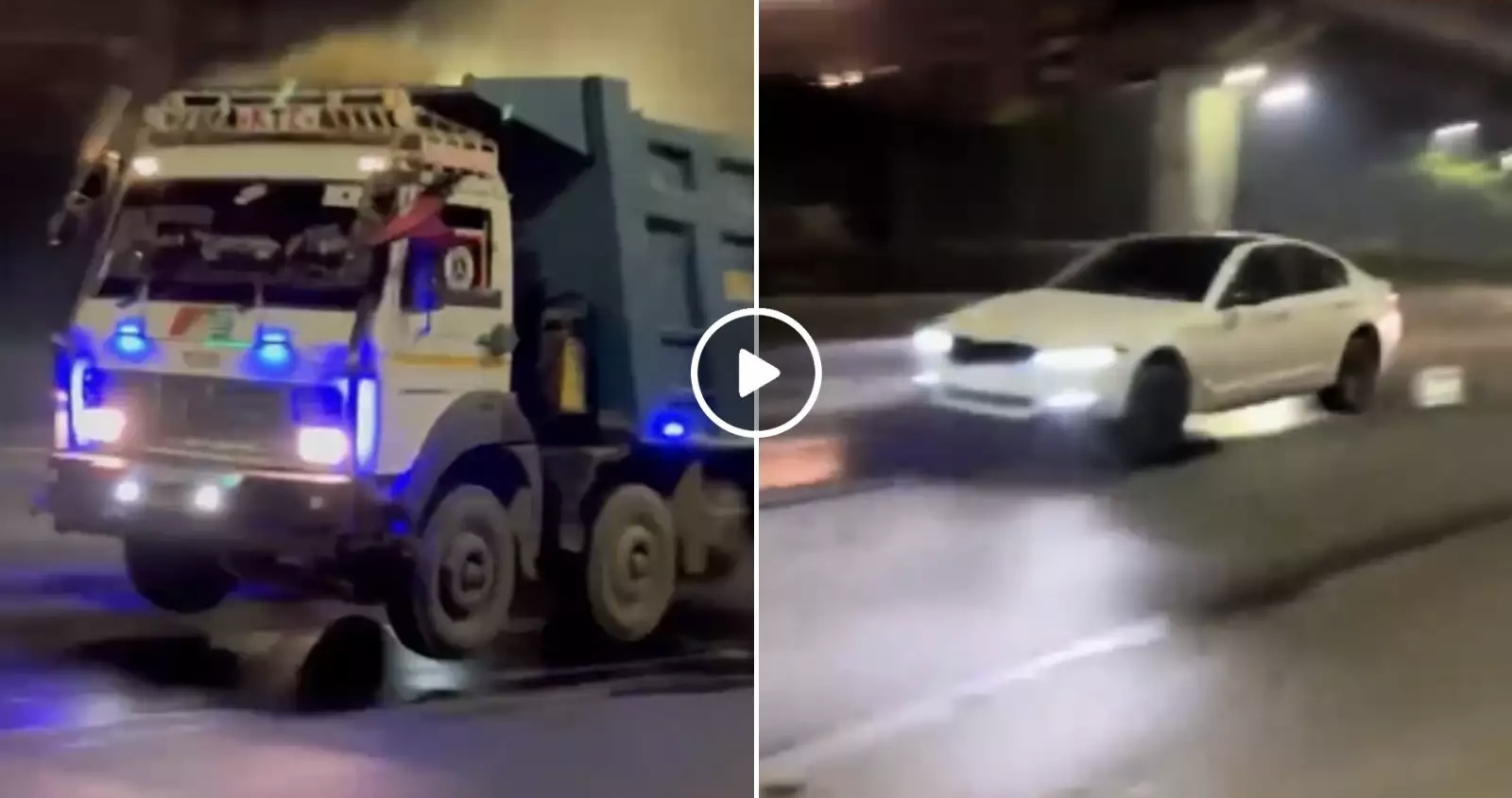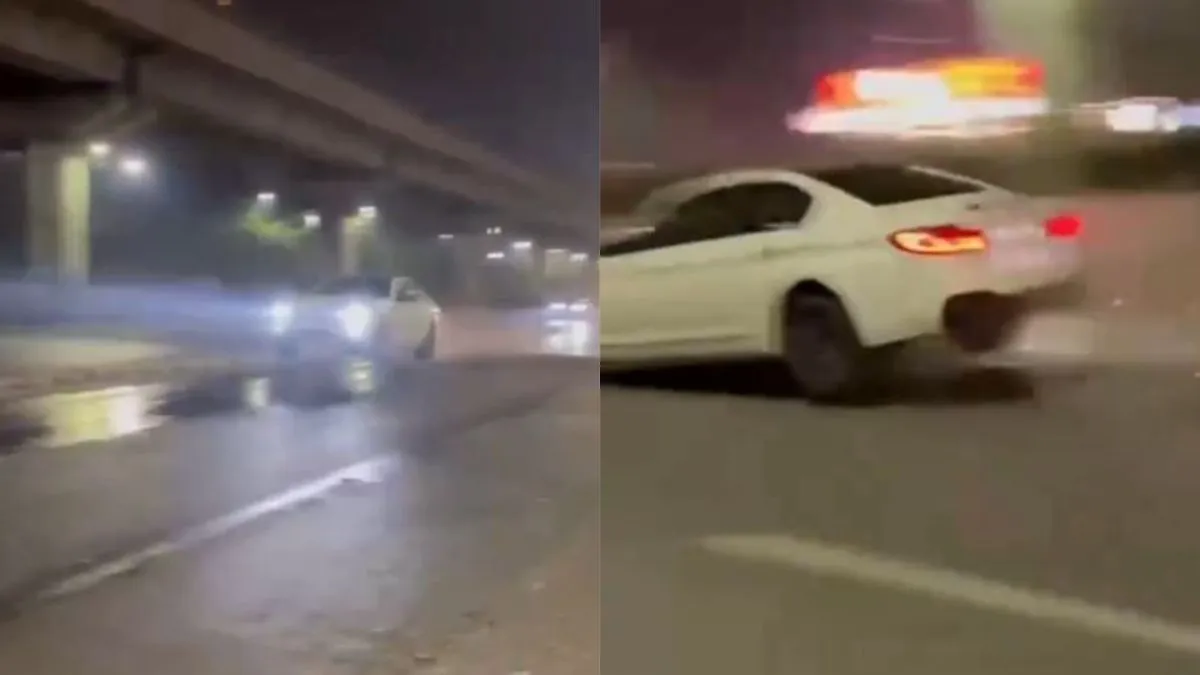Flying Cars, Deadly Roads In Gurugram. Why Indian People’s Lives Put At Risk For Basic Infrastructure Failure? How Many Lives To be Lost Before Authorities Take Some Action?
Recently, a video emerged from Gurugram, and it is going viral concerning road safety as several vehicles, including a luxury BMW and heavy trucks, have been flying in the air after hitting an unmarked speed breaker. This incident occurred at Golf Course Road near Sector 54 and raises the critical issue of the maintenance and safety measures regarding road infrastructure in urban areas.

Once a tender for road construction or modification is sanctioned, it seems that everyone in the chain-from contractors to local officials-treats it as a job done. What about inspections? What about follow-ups to ensure safety measures are up to the mark? The answer usually is silence. This lack of oversight is how something as dangerous as an unmarked speed breaker can exist on a busy stretch of road without anyone raising an alarm.
This is plain and simple negligence. No reason or excuse for complete disdain from safety standards. Planning for a new road and new roads is quick enough. Launching it too. Ensuring it at the most basic level is nothing to talk about. There are speed breakers strewn about, but then one might say this is but a single city’s or one-speed breaker; that is an epidemic.
Gurugram’s GMDA, like almost all the city authorities around India, is given the safety responsibility. This aspect of their work is treated as a matter of procedure. Regular audits seem far from reality; ground inspections have rarely been seen, and ignoring public feedback altogether is a huge failure that has transformed the streets of Gurugram into possible death zones.
The public will want to know why this was not marked. Why on earth did nobody notice this blaring safety violation? When they did notice, why could nothing be done about it? GMDA has an obligation to ensure that roads remain safe for everybody who wishes to use them, though incidents like these make their commitment to public safety painful to think about.
Community Complaints: Unheard Voices
One thing is for sure—it was no unknown issue. The residents and frequent road users on Golf Course Road knew of the unmarked speed breaker and the danger it posed. Social media had been filled with similar comments from people who shared such experiences about near misses and the hazardous experience they were left to encounter with this speed breaker. Many reported having a chance to see it only when they were left to creep close to the speed breaker, and thereby, there was no time for braking.
Unmarked speed bumps, potholes, and other hazards have been complaints on roads for years. They file their complaints, submit their petitions, and go to officials. But that is where the complaint or petition stops. Officials do nothing about these concerns. Why are their voices unheard? The public deserves safe roads. They deserve to drive without fear for their lives from poorly marked or unmarked hazards. Reality shows that citizen complaints are turned into the backburner as inconveniences, rather than urgent warnings.
This is a slap in the face of every citizen who has ever complained about road safety issues. Public feedback should be the very core of how the authorities prioritize road safety. But here, it is as if the people for whom public infrastructure is developed have no say in the maintenance or the safety standards of the very infrastructure designed for them. And that is precisely why tragedies like the Gurugram incident continue to happen.
A Pattern of Neglect: Similar Incidents Across India

This is not an isolated case by Gurugram. The disturbing pattern is the same as in other parts of India- accidents caused either by ill-marked speed breakers or by completely unmarked speed breakers. Mumbai’s roads are infamous for it. Coimbatore, as brought out earlier, is a city riddled with them. Bangalore has a survey to report that an alarming number of speed breakers fail to meet the standards set by the Indian Roads Congress, and some even have been constructed illegally.
Each of the cities shares the same tragic story. In Mumbai, accidents with two-wheelers seem to occur regularly because most speed breakers are unmapped. A motorist cannot see the speed breaker in time and falls off the motorcycle, incurring severe injuries or dying. When such tragedies involve families, rarely is the family heard or compensated. The authorities state their case and promise to act in a decisive manner more than once. Still, the cycle repeats. Nothing seems to change.
Speed breaker bumps on the roads of Delhi major roads are not given markings. This poses risks for thousands of daily commuting users. The driver can only slam his brakes upon these bumps and run into a rear-end collision and possibly worse. Speed breakers at several places in Pune have caused accidents. In some other places, they were constructed without warning signs or, for that matter, with a complete disregard for safety parameters. Unmarked or inadequately marked speed breakers are silent killers on India’s roads.
The fact that such incidents are recurrent is an indication that there’s a systemic failure in the management of road safety in this country. The issue here goes deep inside the bureaucratic ineffectiveness along with the overall negation towards public welfare and not that bad roads, and here, human life becomes something that’s discarded.
The Public Backlash through Social Media
Such a type of incidents are igniting rage on the social media of Gurugram, and citizens are immediately using X (formerly Twitter), like social media platforms to display their rage and frustration. People slammed the local authority for its negligence in failing to mark the speed breaker aptly, saying it is an act of “criminal negligence.”
Scores of people flooded comments by sharing such experiences about hazards on the roads they traverse daily. This was not limited only to Gurugram; the country was flooded with such complaints. Ampling it through social media with all those frustrated citizens increased nationwide attention to what is simply a localized incident when some of the users required instantaneous action and accountability for whatever caused it.
The anger wasn’t just about one speed breaker; it was against a much deeper issue: road safety in India. They have had enough of risking their lives on poorly maintained roads. People are tired of living with constant fear that any drive may be their last because nobody cares enough to ensure that a basic level of safety is maintained.
The citizens demanded that the officials tender their resignation, rectify all undesignated speed breakers right away, and the authorities not make the same mistake again in the future. Some users said that it is a metaphor for how public safety is pushed on the backburner by bureaucratic red tape and negligence. Others pleaded with the state government and the Ministry of Road Transport and Highways to get proper involvement and serious actions that stay strong with the end of the spotlight.
This incident brought forth the potential of social media to check authorities and to bring forward issues that may otherwise lie in obscurity. At the same time, this incident also highlighted how ubiquitous and relevant the issue was for people from all parts of India as citizens themselves narrated experiences of driving on dangerous roads, vague markings on speed breakers, and the risk each day involves while commuting.
A Failure of Infrastructure Management
Infrastructure in a developing city like Gurugram is expected to develop with the growth requirements of its residents. Here, we are experiencing a total infrastructure management breakdown. There is a basic non-understanding on the part of the GMDA who are entrusted with managing roads. How does such a significant safety feature as speed breakers go without even putting marks on it for motorists plying on an almost 24×7 busied road? And how is this all made possible by nobody being attentive until a viral scandal occurred?
It includes safe, usable, and efficient public spaces. Indeed, this is a rude reminder that building infrastructure alone is not sufficient; rather, it requires constant maintenance, inspection, and quality checks to ensure it adheres to all the safety standards. The sad reality is that most of the time, new constructions come first at the expense of maintaining existing infrastructure, which poses hazards to the public.
This indicates that the infrastructure management in Gurugram is in shambles. The people in the administration need to be made aware of the problems, or they will not do anything about the problems. Such negligence finds a pattern all over India’s urban belts as cities expand with lightning speed, but their management needs to be more prepared for the pace of growth. The result is that bad roads and ill-defined hazards stand as clear testimony to ignoring the safety of commuters at large.
Earlier Accidents: The Shocking Data
If seen from the number of deaths, it even shows a very pitiable situation. In the years 2013 to 2021, at least 4,500 deaths happened only because of speed breakers in states like Madhya Pradesh that were not marked or were poorly designed, as stated in NCRB’s report. That is the count of reality that was denied with just simple prevention at those stretches of the roadways.
For example, take the case of Mumbai: research here has established that the main road speed breakers need to be marked or marked. This again shows to affect two-wheeler persons more as they are likely to be at the bottom of the hit list of the accident causalities, and many of these two-wheelers suffer critical injuries with some even resulting in losing their lives. Families are separated, lives are lost, all because of a mere mistake—a mistake that could have been corrected.
In Coimbatore, faded or absent markings on speed bumps have caused numerous accidents. The issue isn’t that the speed bumps are there; it is that they are nearly invisible to the drivers who only see them when it is too late. And in Pune, it has been seen that most speed breakers are built without any reference to some common guidelines or standards. Thus, the bumps should be lowered, correctly placed, or even unmarked. It is really appalling that such violations of safety arrangements exist.
It tells us that there is a failure at all levels. The IRC has specific rules for the visibility, height, and placement of speed breakers, but those need to be followed, and no one is answerable for them. This type of negligence has claimed the lives of people in such accidents.
The Role of Corruption and Bureaucratic Indifference
With every such incident, there is a factor below which cannot be avoided altogether: corruption and bureaucratic insensitivity. Indian infrastructure projects are infamous for corruption, and most tenders have been awarded to such contractors who may not provide emphasis on quality or safety factors. The officers keep watching the whole show just by taking bribes and being favoured. This culture of corruption has sunk so deep into the social fabric that it almost appears to be an inevitable feature of how things are.
Bureaucratic apathy does not help. Even when complaints are lodged by citizens, there is little incentive to act by the authorities. Requests for repairs, repainting, or additional signage may be met with delays or ignored. Officials responsible for road safety hardly face any accountability when they do not perform their duties. It is a system of dodging accountability and letting common citizens pay the price.
What will it mean for the average member of the public? Live with the daily fear of something as small as the speed breaker becoming a cause of death. Drive timidly, hoping not to pass an unmarked speedbump, pothole, or some other threat that might lead to disaster. It is unacceptable if this is the kind of fear and uncertainty that goes with living in a manner caused by corruption and carelessness at the highest.
An Urgent Call for Action: What Needs to Be Done


This gurugram incident calls everyone to wake up and alert. The government authority cannot be so numb while continuing to disregard road safety standard norms. There should now be real action, account, and commitment seriously devoted to public safety protection.
1. Speed breakers on the road should be mapped, marked, and inspected immediately so that they do not fail the safety tests. This needs to happen not only in Gurugram but across all of India.
2. Local authorities should periodically conduct audits on the roads to identify hazards like unmapped speed breakers, potholes, and the rest. The audit needs to be transparent and publishable.
3. There are road safety authorities to which one can report and question the negligence of road authorities that may cause accidents. Punishment, suspension, and court action are among the severe measures against them in cases of gross negligence.
4. The local government should take inputs from residents and commuters. The users of these roads know them like the back of their palm and first point out any abnormality. Their inputs should be treated with seriousness and acted on.
5. Strict implementation of IRC Speed Breaker Standards. Speed breakers by the Indian Roads Congress should be strictly implemented, which includes height, marking, and placement so that speed breakers are clearly visible and appropriately placed.
Final Words: Enough Is Enough
The time for excuses is over. It’s one more day every citizen puts their life in risk and faces the menace if there are no solutions. No question about it; these problems do not involve having to bear an uncomfortable ride, or frustration over poor infrastructure, no. It is a question of lives. Families are losing relatives, people are being wounded and those dreading reaching work.
Gurugram’s nameless speed breaker has itself become a symbol for all that is wrong about how road safety has been handled in India. That is to say, all those things that value the bureaucracy over its people, shortcuts over standards, corruption and above all, a callousness by placing lives in danger.
We must act quickly and act quickly. The authorities must do something more concrete and meaningful now. For every citizen, commuter, and family that has lost a loved one due to these disasters, we have to demand more. We deserve safe roads, good infrastructures, and officials who care for the lives of the people they serve.
It is not just fixing a speed breaker but fixing a broken system that has failed us for far too long.




